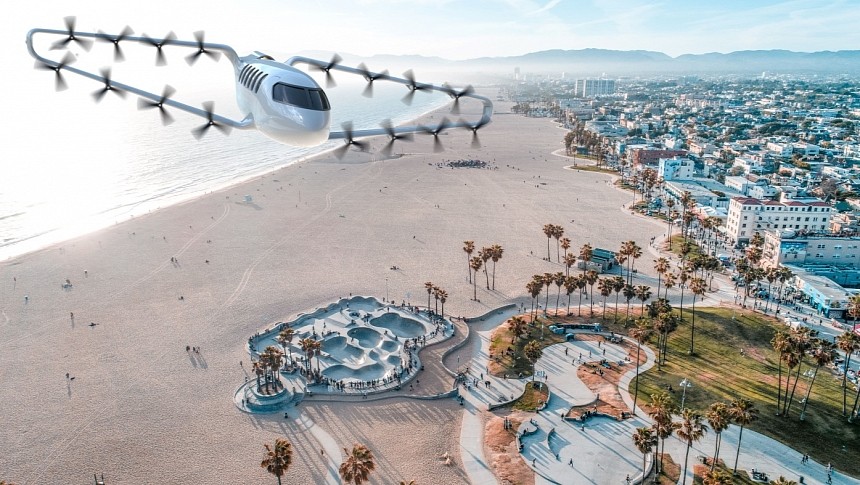Most eVTOL (electric vertical take-off and landing) developers have a diverse, international customer portfolio. Still, they don’t often get funding from another country's government. Odys Aviation is one of the few, and its main partner is the United Arab Emirates (UAE) 's Ministry of Economy.
Lots of AAM (advanced air mobility) companies in the US are based in California, but one of them will be assembling its electric air taxis all the way in Abu Dhabi. Odys Aviation is currently setting up regional headquarters in the area, with plans to add an assembly and maintenance facility in the near future.
This move to UAE is not the result of a commercial partnership but of the NextGen FDI program. UAE's Ministry of Economy launched this program last year to encourage high-tech companies to relocate to the UAE. The Californian startup is one of the businesses benefitting from this financial support, with a highly ambitious goal – the Odys-designed eVTOL will become the first aircraft to boast a "Made in UAE" certification and be exported as such.
Two things set apart the Odys aircraft from other eVTOLs. The first is a hybrid propulsion configuration. Fully-electric VTOLs have a limited range and require specific infrastructure. Hybrid alternatives can significantly extend that range and enter service faster. The Odys VTOL can only promise a 200-mile (321 km) range when using batteries exclusively but increases that to 750 miles (more than 1,200 km) when switching to a hybrid-electric mode.
Another benefit for regional flights is the Odys aircraft's size. Unlike most eVTOLs, it has enough room for up to nine passengers plus two pilots. Traveling at 345 mph (555 kph), it can comfortably handle both short-haul trips and regional routes. The Californian startup claims that this hybrid air taxi has all it takes (from range to capacity) to operate effectively on more than half of the domestic air routes in the US.
The Odys aircraft is also different than other eVTOLs in terms of design. Box wings and a flap-based take-off system replaced the commonly-used tilting fans. This aircraft uses flap-based vectoring to generate lift, claiming to be a safer and more stable alternative to tilting fans and rotors.
One of the potential drawbacks of hybrid-electric VTOLs is the higher level of toxic emissions compared to battery-electric aircraft. However, the Californian startup is looking at the green jet fuel known as SAF (sustainable aviation fuel) for its VTOL's conventional gas turbines. By combining hybrid propulsion with the use of SAF, VTOLs can cut emissions by almost 80% compared to traditional jets, making them even more sustainable.
Until it opens the gates to a new assembly facility in Abu Dhabi, Odys Aviation is working on a full-scale prototype to be launched in 2025. If things go according to plan, the California-designed aircraft, built in UAE, will be ready for commercial operations in 2027.
This move to UAE is not the result of a commercial partnership but of the NextGen FDI program. UAE's Ministry of Economy launched this program last year to encourage high-tech companies to relocate to the UAE. The Californian startup is one of the businesses benefitting from this financial support, with a highly ambitious goal – the Odys-designed eVTOL will become the first aircraft to boast a "Made in UAE" certification and be exported as such.
Two things set apart the Odys aircraft from other eVTOLs. The first is a hybrid propulsion configuration. Fully-electric VTOLs have a limited range and require specific infrastructure. Hybrid alternatives can significantly extend that range and enter service faster. The Odys VTOL can only promise a 200-mile (321 km) range when using batteries exclusively but increases that to 750 miles (more than 1,200 km) when switching to a hybrid-electric mode.
Another benefit for regional flights is the Odys aircraft's size. Unlike most eVTOLs, it has enough room for up to nine passengers plus two pilots. Traveling at 345 mph (555 kph), it can comfortably handle both short-haul trips and regional routes. The Californian startup claims that this hybrid air taxi has all it takes (from range to capacity) to operate effectively on more than half of the domestic air routes in the US.
The Odys aircraft is also different than other eVTOLs in terms of design. Box wings and a flap-based take-off system replaced the commonly-used tilting fans. This aircraft uses flap-based vectoring to generate lift, claiming to be a safer and more stable alternative to tilting fans and rotors.
One of the potential drawbacks of hybrid-electric VTOLs is the higher level of toxic emissions compared to battery-electric aircraft. However, the Californian startup is looking at the green jet fuel known as SAF (sustainable aviation fuel) for its VTOL's conventional gas turbines. By combining hybrid propulsion with the use of SAF, VTOLs can cut emissions by almost 80% compared to traditional jets, making them even more sustainable.
Until it opens the gates to a new assembly facility in Abu Dhabi, Odys Aviation is working on a full-scale prototype to be launched in 2025. If things go according to plan, the California-designed aircraft, built in UAE, will be ready for commercial operations in 2027.







